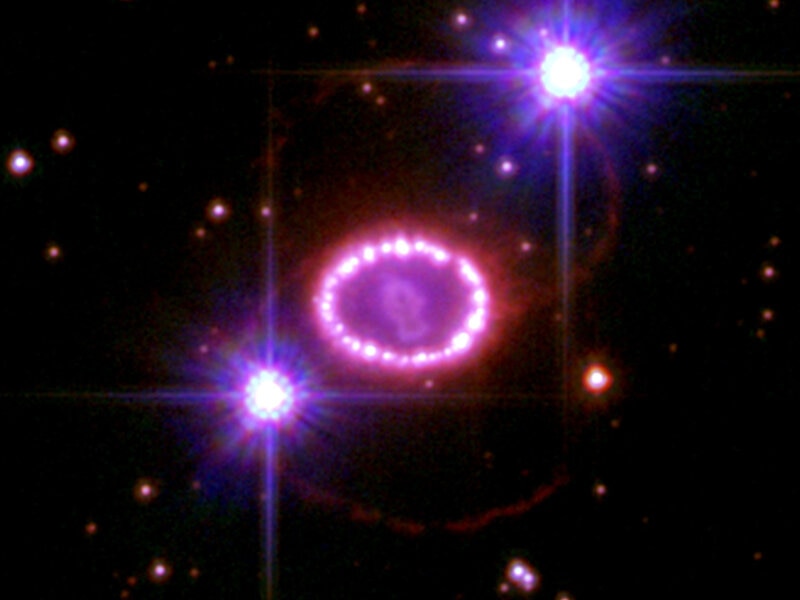Create a free profile to get unlimited access to exclusive videos, sweepstakes, and more!
Happy 25th anniversary, Supernova 1987A!

[Note: This is a repost of what I wrote on February 23, 2007, the 20th anniversary of the day light reached us from Supernova 1987A, the brightest supernova that had been seen for centuries. Not a whole lot has changed since I posted this, including my opinions on it, so I figure I'll give it a second chance (I kept all the dates the same as they were five years ago, so be aware of that as you read it). That exploding star 1.6 quintillion kilometers away certainly changed my life - I could even say I got married because of it, though that's a story for a later time - and it's all been pretty good, I must say.]
Has it really been 20 years since Sanduleak -69 202 blew up? Wow.
Of course, that's Supernova 1987A to you. And if that doesn't ring a bell, this image might:
That image, from Hubble, was released as part of the 20th anniversary of the closest supernova in 400 years. It's amazing-- we know so much about this event now, and I know a lot of people -- including me -- who would have killed for this knowledge back in, say, 1990. But we still don't understand a lot about it too.
If you want a history of this object, I won't belabor it here, since I have details in an article I wrote about 87A. In fact, that is the first part of a series of short articles I wrote about the supernova (at the end of each is a link to the next). But the early days were very confusing. It was thought only red supergiant stars could explode, but this one -- named Sanduleak -69 202 -- was clearly blue when it detonated. It emitted ultraviolet light as expected, but the amount was weird-- it got brighter and fainter in an odd way, as if it had a cloud of gas around it. The best images we could do, pre-Hubble, did show some sort of elliptical envelope of gas, but the UV light didn't match the shape seen.
It wasn't until we got the Hubble images in 1990 that we saw that inner ring, and things made a little more sense. We could see that it wasn't a complete shell (like a football), it was a flat ring! But then we realized we still had a problem: how did that ring get there? And what were those fainter arcs above and below it?
 I was in the thick of it back then. I had just started my PhD research, signing on with a large project to look at exploding stars with Hubble. I signed up just before launch, so I got to live through the trauma of learning about the flawed mirror, and getting the fuzzy data. I spent months learning how to clean up the data, and wishing for just a few more photons, and lying awake at night (after getting our first meager data on 87A) staring at the ceiling trying to figure out just what the heck that ring was.
I was in the thick of it back then. I had just started my PhD research, signing on with a large project to look at exploding stars with Hubble. I signed up just before launch, so I got to live through the trauma of learning about the flawed mirror, and getting the fuzzy data. I spent months learning how to clean up the data, and wishing for just a few more photons, and lying awake at night (after getting our first meager data on 87A) staring at the ceiling trying to figure out just what the heck that ring was.
Lots of false starts. Lots of dead ends. Lots of great ideas smashed by reality. Lots of math. Lots more math. Lots of meetings, lots of talking, lots of sitting in front of a computer learning about deconvolution, pointing constraints, spectral analysis, Fortran, IDL, Unix.
In the end, I was able to cobble enough together to write a scientific paper and get my PhD in 1994. A lot of what I (and my collaborators of course) were able to figure out turned out to be right, and some turned out not to be. No matter how you slice it, Supernova 1987A is a weird object. For a long time we knew of nothing else like it, but eventually (really, quite recently) people found similar objects. Not that we understand how you can get those three rings like that-- that's still a mystery, even after 20 years.
Wow, 20 years. Well, the Universe ticks on. During that time, the inner ring faded as the initial blast of light from the explosion wore down, but then it rebrightened years later as gazillions of tons of hot gas from the exploded star begin to reach the ring. The supernova itself was at first an unresolved dot, but as you can see from the image above it's expanded greatly over two decades. It's an elongated cylinder of material now, getting bigger every day.
And it won't stop, not for thousands of years. After 7305 days, it's stretched out to be a goodly fraction of a light year, but it's still screaming along at thousands of kilometers per second. It'll slam into the inner ring, eventually dispersing it (that'll take decades, probably). A few hundred years later it'll reach the outer rings, and blast them apart too. Maybe eventually it'll look like the Crab Nebula; there're some indications the explosions were a bit similar. Even then it'll go on, getting bigger and fainter, looking like the Vela remnant, and then Simeis 147, and then it'll fade, mix, and merge into the ambient gas surrounding the other stars in the outskirts of the Tarantula nebula, where the star that made the supernova was born. No doubt by then more of the stars in its neighborhood will blow up; the place is lousy with massive stars just waiting to go off. They'll have their turn, and future astronomers can marvel over them, as well.
I hope they have as much angst, sleepless nights, head-scratching, wonder, joy, awe, and fun as I did looking at Supernova 1987A. Isn't that the point?
Note added after I edited this, but before I posted it: Amazingly, while looking up some info about the star that exploded, I stumbled on the announcement that the mystery of the origin of the three rings may be solved! It's been speculated for a while that the star that blew up was originally a binary star, two stars orbiting each other. If one was more massive than the other, then it could have literally swallowed the smaller one up when it expanded into a red supergiant (it turned blue later). The smaller star spiraled into the bigger one, eventually reaching and merging with the more massive star's core. As it spiralled in, it "spun up" the more massive star, making it rotate faster and flattening the equatorial regions into a disk. That's how the inner disk may have formed. Eventually, much of the outer gas of the merged stars was ejected in various stages, and the complicated ejection mechanism may have formed the outer rings. New models by Podsiadlowski, Morris, and Ivanova appear to confirm this idea mathematically, which is fantastic news! It's not 100% certain, of course, but it's a great step toward understanding. And that, most certainly, is the point.
Update (late on February 23): the wonderful and talented Jennifer Ouellette, whose name I cannot type correctly on the first try no matter how much I want to, has much more meaty info on this.















